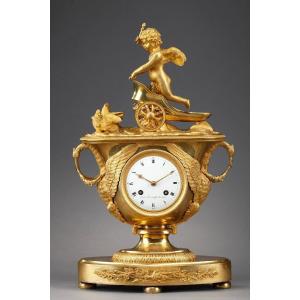See our website for more detailed photos: LINK
We send this article worldwide, professionally packaged, with registered and fully insured shipping at a fair price.
A distinguished French Empire period clock, surmounted by a finely sculpted figure of Hera seated amidst the clouds, with a majestic peacock at her side. The movement, featuring a white enamel dial, is supported by Zeus in the form of an eagle with outstretched wings, clutching thunderbolts. He is flanked by figures of Renown and putti, adorned with garlands of foliage. The entire composition rests on a sea green marble base, encircled by a frieze of stylised palmettes and supported by six elegantly crafted feet.
This clock showcases a high level of artistry, evident in the refined sculptures. Hera, the goddess of marriage, is depicted wearing a diadem, an ornamental headband signifying royalty, and holding a sceptre, symbolising her regal authority. The peacock, with its intricately detailed feather headdress, adds a stunning visual element, while the eagle symbolises Zeus, Hera’s husband and brother.
The clockwork includes a white enamel dial signed “à Paris,” with Roman numerals for the hours and Arabic numerals indicating every 15 minutes. It features a wire-suspended pendulum and anchor escapement, striking the hours and half-hours on a bell regulated by a count wheel. The mechanism is in perfect working order, complete with the pendulum, bell, and key.
This Empire mantel clock, rich in sculptural detail and craftsmanship, is fashioned from finely chiselled mercury gilded bronze. It has been professionally cleaned and is in excellent condition.
Origin: Paris, circa 1810.
Dimensions: 46 cm (18.1″) high, 36 cm (14.2″) wide and 13 cm (5.1″) deep.
Mythology of the goddess Hera
In ancient mythology, Hera is revered as the patron goddess of marriage. She presides over weddings, bestowing blessings and legitimacy upon marital unions, and offers protection to women during childbirth. Hera is widely recognised as the maternal figure of Greek mythology. She is both sister and wife to the god Zeus and serves as the queen of the twelve Olympians and of Mount Olympus. A defining characteristic in her mythology is her jealous and vengeful nature, particularly towards those who offend her, especially in response to Zeus’s numerous lovers and the children he fathered with them.
In classical art, Hera is often portrayed as a dignified and matronly figure, typically seated on a throne and crowned with a polos or diadem, sometimes veiled as befits a married woman. Her symbols include the royal sceptre and crown, and she is frequently accompanied by animals sacred to her, such as the cow, lion, and peacock.
The peacock, however, only became associated with Hera after Alexander the Great’s conquests in the East, as the bird is not native to Greece and was unknown to the Greeks prior to that period.


































 Le Magazine de PROANTIC
Le Magazine de PROANTIC TRÉSORS Magazine
TRÉSORS Magazine Rivista Artiquariato
Rivista Artiquariato